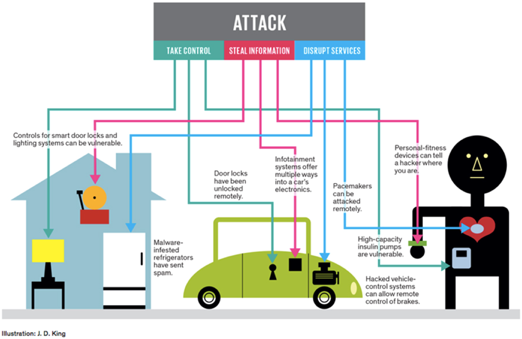Richard Alexander explains why the Internet of Things (IoT) is so much more than fridges that tell us the milk has gone bad, or that you’re running low on eggs - and what its sheer scale means for vendors and service providers.
To truly grasp the scale of IoT, you need to take a step back and look at what the Internet looks like today from a device connectivity standpoint. It's estimated there are between 9 and 10 billion connected devices today, made up mostly of the Apple devices I have floating around my pockets and wrists, some desktops/laptops that we use to look busy, and a small portion of the new industrial and consumer products we count as ‘things’. Getting these billions of devices online has taken the 45 years the Internet has been alive – which works out at around 608,828 devices hitting the net per day over that time. Conservative predictions for the Internet of Things suggest that there will be 50 billion devices connected by 2020, which works out at another 21,917,808 devices per day for the next five years. That gives you an idea of the scale of the Internet of Things, but it is also important to understand the nature of these devices, or ‘things’.
So, what will they be? Well there will be some fridges (and kettles, light bulbs, microwaves, and all manner of household devices), but the nature of IP means that we can connect anything at all. Lets give a few examples:
- The keys to your car - it won't be a key in the traditional sense of course, it will be a device able to communicate with a security ‘hub’ to establish your identity and work out whether you are authorised to access the "service".
- Then there’s the car itself. It’s connected, so no matter who is driving, you will know where it is, how fast it’s travelling, whether it it need a software update and so on.
- The road is connected too. It knows how many cars are travelling along it, what's the best route for you to maximise fuel efficiency, and where road or traffic conditions have changed.
What does IoT mean for business?
Some businesses are already taking advantage of IoT – I know of a supermarket, for instance, which is using smart displays to track stock levels and sell by dates, and to ensure items are displayed in their most “likely to be bought" positions.
That is a quite specific and limited application, and the full opportunity for business is massive. The potential to gather and act on insight from IoT is almost endless – but it is so big that specialist support and services will be required:
- I4T - the Infrastructure for Things. All these ‘things’ are going to need to be connected to the web somehow, and businesses will need access to a wealth of skills in designing, deploying and supporting the necessary wired and wireless communications infrastructures. In addition, they are going to need somewhere to store data and provide information to the applications that unlock the value in this data, so data centre infrastructure skills and capability will be vital too.
- IfT - the Information from Things. A lot of these things won't be sending much in the way of structured data, so information insight technologies and expertise will be in great demand - particularly the ability to gather meaningful insight in real time.
- Security. The IoT opens the world to a whole new wave of attack vectors. 50 billion devices open to attack is a scary prospect, especially when you consider what will be exposed to attack. Two examples here - very recently hackers in the US exposed the drive by wire systems of a couple of Jeep Cherokees via vulnerabilities within their infotainment systems - and disabled the brakes. Secondly authorities were recently alerted to a spambot responsible for sending many millions of emails - upon investigation it turned out to be a smart fridge.
The picture below gives a great summary of the technological and skills challenges and opportunities inherent in IoT.
Make no mistake, the challenge for vendors and service providers is significant. The task will be to provide the infrastructure and expertise required to seize the opportunity inherent in IoT – while helping their clients to secure their communications: man-to-machine and machine-to-machine; to protect their data; and, most important, to protect their users.


